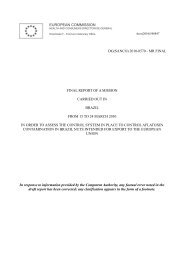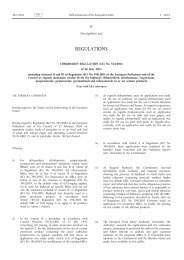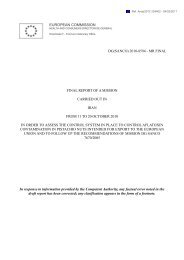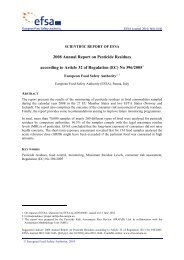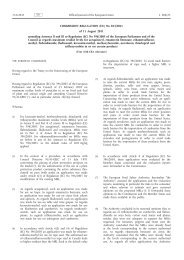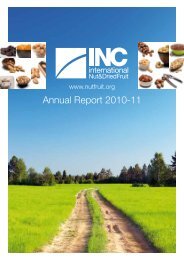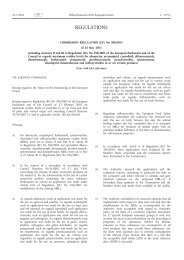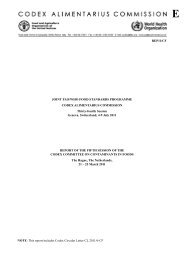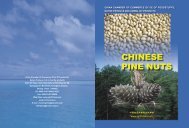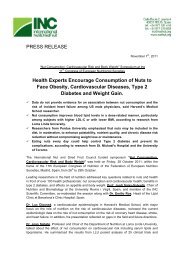Download - International Nut and Dried Fruit Council
Download - International Nut and Dried Fruit Council
Download - International Nut and Dried Fruit Council
Create successful ePaper yourself
Turn your PDF publications into a flip-book with our unique Google optimized e-Paper software.
superseded by revised crop groups, but EPA will not establish newtolerances for the pre-existing groups. EPA plans to eventually converttolerances for any pre-existing crop groups to tolerances with thecoverage of the revised crop group. This conversion will be effectedboth through the registration review process <strong>and</strong> in the course ofestablishing new tolerances for a pesticide. Therefore, no specificfruiting vegetable group 8 pesticide tolerances will be converted totolerances for fruiting vegetable group 8-10, including goji berry,upon codifying the revised fruiting vegetable crop group 8-10 in theCFR. Pesticide residues on any additional members of a revised cropgroup will not be legal until the EPA establishes a new tolerance forthat pesticide on the revised crop group.EPA will propose new tolerances for the revised crop group in theFederal Register <strong>and</strong> provide an opportunity for public comment,consistent with U.S. law. The U.S. also plans to continue to notify theWTO of proposed tolerance actions, consistent with the WTO/SPSAgreement. If commenters believe that any of the tolerances that areproposed in the future will not be adequate for any form of a commoditythat is in the crop group, they should submit comments <strong>and</strong> supportingdata on the specific tolerances when they are proposed <strong>and</strong> notified.Another commenter noted that it would be beneficial for theEuropean Union (E.U.) <strong>and</strong> North American Free Trade Agreement (NAFTA)crop groups to be harmonized, in much the same way as the U.S. <strong>and</strong>Canada are working with the Codex Committee on Pesticide Residues(CCPR) to harmonize NAFTA crop groups with those being developed aspart of the revision of the Codex Classification of Foods <strong>and</strong> Feeds.EPA recognizes the benefits of internationally harmonized cropgroups, <strong>and</strong> notes that the E.U. has been involved in the efforts todevelop the Codex crop groups <strong>and</strong> to revise the NAFTA crop groups.Petitions submitted to the EPA to revise crop groups are developedby the <strong>International</strong> Crop Groupings Consulting Committee (ICGCC), whichis an international body that includes NAFTA, Codex, <strong>and</strong> E.U. members.The ICGCC workgroup members provide valuable internationalperspectives, including commodity <strong>and</strong> MRL information, in developingcrop group proposals to be submitted to the EPA. Beyond the NAFTApartner involvement in developing Codex crop groups, other CCPRdelegations from the E.U. <strong>and</strong> around the world provide internationalinput <strong>and</strong> participate in the process. Through the partnership with theCCPR, the EPA believes that the NAFTA crop group revisions are beingharmonized with Codex to the extent possible at this time; the E.U.will have to ultimately determine to what degree it will align with theCodex crop groups that are established.Finally, EPA received a comment concerning ``zero tolerance'' beingunachievable.The purpose of the crop revisions is to provide a vehicle toestablish tolerances for residues of pesticides on food commodities.Therefore, the comment regarding ``zero tolerance'' does not apply tothis action.V. The Final RuleAfter fully considering all comments, EPA is promulgating the ruleas proposed.VI. ImplementationWhen a crop group is amended in a manner that exp<strong>and</strong>s or contractsits coverage of commodities, EPA will (1) retain the pre-existing cropgroup in 40 CFR 180.41; (2) insert the revised crop group immediatelyafter the pre-existing crop group in the Code of Federal Regulations;<strong>and</strong> (3) title the revised crop group in a way that clearlydifferentiates it from the pre-existing crop group.The revised crop group will retain roughly the same name <strong>and</strong> numberas the pre-existing group except the number will be followed by ahyphen <strong>and</strong> the final digits of the year established. (e.g., Crop Group8-10).EPA will initially retain pre-existing crop groups that have beensuperseded by revised crop groups. EPA will not establish newtolerances under the pre-existing groups. Further, EPA plans toeventually convert tolerances for any pre-existing crop group totolerances with coverage under the revised crop group. This conversionwill be effected both through the registration review process <strong>and</strong> inthe course of evaluating new uses for a pesticide. EPA requests thatpetitioners for tolerances address this issue in their petitions.For existing petitions for which a Notice of Filing has beenpublished, the Agency will attempt to conform these petitions to thisrule.VII. Statutory <strong>and</strong> Executive Order ReviewsA. Executive Order 12866Under Executive Order 12866, entitled Regulatory Planning <strong>and</strong>Review (58 FR 51735, October 4, 1993), the Office of Management <strong>and</strong>Budget (OMB) has designated this proposed rule as a not-significantregulatory action under section 3(f) of the Executive Order.



